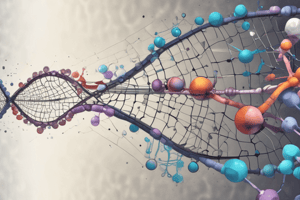Podcast
Questions and Answers
Where does protein synthesis occur in cells?
Where does protein synthesis occur in cells?
- Golgi apparatus
- Endoplasmic reticulum
- Ribosomes (correct)
- Lysosomes
What is the first stage of amino acid catabolism?
What is the first stage of amino acid catabolism?
- Decarboxylation
- Lysosomal proteolysis
- Transamination (correct)
- Deamination
What is the primary function of peptide hormones?
What is the primary function of peptide hormones?
- Synthesize urea
- Regulate protein synthesis
- Regulate various physiological processes (correct)
- Break down proteins into amino acids
How many enzyme-catalyzed reactions occur in the urea cycle?
How many enzyme-catalyzed reactions occur in the urea cycle?
What is the primary site of protein degradation?
What is the primary site of protein degradation?
What is the final product of the urea cycle?
What is the final product of the urea cycle?
What is the function of ubiquitin-proteasome pathway?
What is the function of ubiquitin-proteasome pathway?
What occurs in the third stage of protein synthesis?
What occurs in the third stage of protein synthesis?
Flashcards are hidden until you start studying
Study Notes
Protein Synthesis
- Process by which cells create proteins
- Occurs in the ribosomes
- Involves three stages:
- Transcription: mRNA synthesis from DNA template
- Translation: mRNA translation into polypeptide chain
- Post-translational modification: folding, modification, and targeting of nascent protein
Amino Acid Catabolism
- Breakdown of amino acids into simpler molecules
- Occurs in the liver and kidneys
- Involves three stages:
- Transamination: conversion of amino acids to alpha-keto acids
- Deamination: removal of amino group (-NH2) from alpha-keto acids
- Decarboxylation: conversion of alpha-keto acids to acetyl-CoA or other metabolites
Peptide Hormones
- Hormones composed of two or more amino acids
- Examples:
- Insulin
- Glucagon
- Thyroid-stimulating hormone (TSH)
- Adrenocorticotropic hormone (ACTH)
- Functions:
- Regulate various physiological processes
- Produced by endocrine glands
- Secreted into the bloodstream
Urea Cycle
- Process by which ammonia is converted to urea
- Occurs in the liver
- Involves five enzyme-catalyzed reactions:
- Citrulline synthesis: conversion of ammonia and ornithine to citrulline
- Arginosuccinate synthesis: conversion of citrulline and aspartate to arginosuccinate
- Arginosuccinate lyase: conversion of arginosuccinate to arginine and fumarate
- Arginase: conversion of arginine to ornithine and urea
- Urea excretion: excretion of urea in the urine
Protein Degradation
- Breakdown of proteins into smaller peptides and amino acids
- Occurs in the lysosomes and proteasomes
- Mechanisms:
- Lysosomal proteolysis: breakdown of proteins by lysosomal enzymes
- Ubiquitin-proteasome pathway: breakdown of proteins by proteasomes
- Functions:
- Regulate protein levels
- Remove damaged or misfolded proteins
- Recycle amino acids for new protein synthesis
Protein Synthesis
- Protein synthesis occurs in ribosomes and involves three stages
- Transcription: synthesis of mRNA from DNA template
- Translation: translation of mRNA into polypeptide chain
- Post-translational modification: folding, modification, and targeting of nascent protein
Amino Acid Catabolism
- Breakdown of amino acids into simpler molecules occurs in liver and kidneys
- Involves three stages: transamination, deamination, and decarboxylation
- Amino acids are converted to alpha-keto acids, then to acetyl-CoA or other metabolites
Peptide Hormones
- Hormones composed of two or more amino acids, produced by endocrine glands
- Examples: insulin, glucagon, thyroid-stimulating hormone (TSH), adrenocorticotropic hormone (ACTH)
- Regulate various physiological processes, secreted into the bloodstream
Urea Cycle
- Process by which ammonia is converted to urea in the liver
- Involves five enzyme-catalyzed reactions: citrulline synthesis, arginosuccinate synthesis, arginosuccinate lyase, arginase, and urea excretion
Protein Degradation
- Breakdown of proteins into smaller peptides and amino acids in lysosomes and proteasomes
- Mechanisms: lysosomal proteolysis and ubiquitin-proteasome pathway
- Functions: regulate protein levels, remove damaged or misfolded proteins, and recycle amino acids for new protein synthesis
Studying That Suits You
Use AI to generate personalized quizzes and flashcards to suit your learning preferences.




